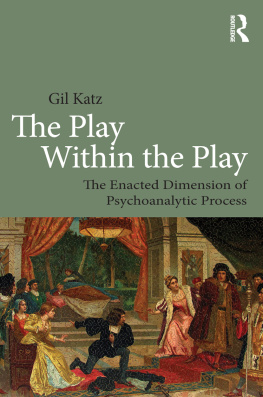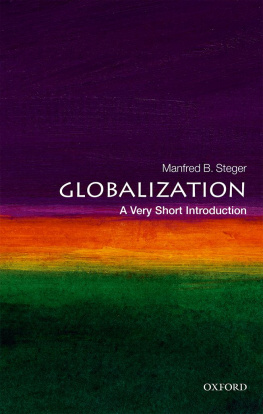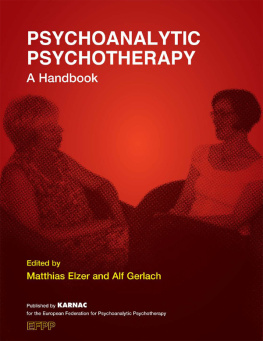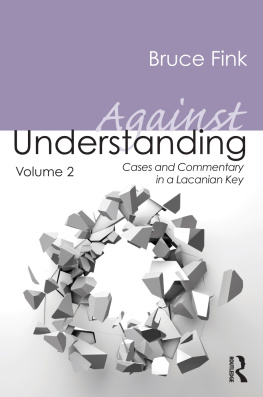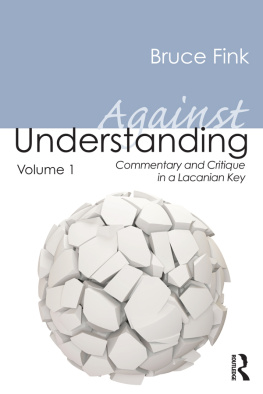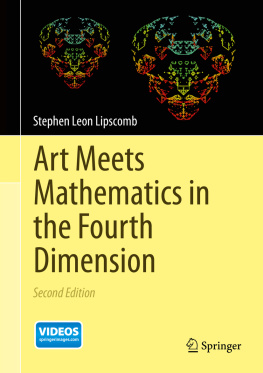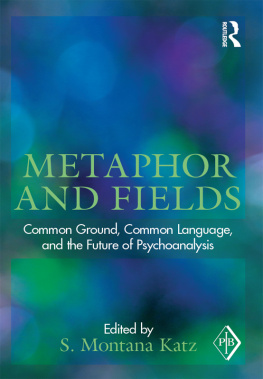
THE PLAY WITHIN THE PLAY
The Enacted Dimension of Psychoanalytic Process
Gil Katz

First published 2014
by Routledge
27 Church Road, Hove, East Sussex BN3 2FA
Simultaneously published in the USA and Canada
by Routledge
711 Third Avenue, New York, NY 10017
Routledge is an imprint of the Taylor & Francis Group, an informa business
2014 Gil Katz
The right of Gil Katz to be identified as author of this work has been asserted by him in accordance with sections 77 and 78 of the Copyright, Designs and Patents Act 1988.
All rights reserved. No part of this book may be reprinted or reproduced or utilized in any form or by any electronic, mechanical, or other means, now known or hereafter invented, including photocopying and recording, or in any information storage or retrieval system, without permission in writing from the publishers.
Trademark notice: Product or corporate names may be trademarks or registered trademarks, and are used only for identification and explanation without intent to infringe.
British Library Cataloguing in Publication Data
A catalogue record for this book is available from the British Library
Library of Congress Cataloging in Publication Data
Katz, Gil A.
The play within the play : the enacted dimension of
psychoanalytic process / Gil A. Katz.
pages cm.
(Relational perspectives book series ; 56)
1. Psychoanalysis. 2. Acting out (Psychology) I. Title.
BF173.K3698 2013
616.8917dc23
2013006553
ISBN: 978-0-415-81966-4 (hbk)
ISBN: 978-0-415-81967-1 (pbk)
ISBN: 978-0-203-79892-8 (ebk)
Typeset in Garamond
by RefineCatch Limited, Bungay, Suffolk, UK
CONTENTS
INTRODUCTION
I became interested in the topic of enactment after I was asked to teach a course on the subject at the NYU Postdoctoral Program in 1996. The course was entitled, Interaction in Psychoanalysis: Transference, countertransference, and Enactment and with what I learned preparing that course, and with what my students in that first class helped me clarify, I wrote the 1998 paper, Where the action is: The enacted dimension of analytic process. In truth, I have always been interested in unconscious communication and the nonverbal aspects of the treatment process (having always been more of a nonverbal kind of person myself), and I had previously written on such topics as the use of metaphor in analytic treatment, and the parallel process phenomenon in analytic supervision (a version of which constitutes ).
The treatment process I wrote about in the 2002 paper, Missing in action: The enacted dimension of analytic process in the treatment of a patient with traumatic object loss (reprinted in ) was actually conducted in the mid-1980s, before the concept of enactment (Jacobs, 1986; Johan, 1992) came into being. Back then, I conceptualized what occurred in the treatment in terms of the concepts of the day, such as projective identification and concordant and complementary countertransference, and presented the case at the 1993 Division 39 meeting with the title A death in the countertransference. Then, after writing the 1998 paper, I returned to the case and reconceptualized my understanding of it in terms of enactment.
As further background, I would also like to say something about the major influences on my analytic thinking and development. The cumulative writings of Hans Loewald, with his object relations conceptualization of Freudian theory and his developmental perspective on clinical work, shaped my early overall approach to psychoanalysis, and the contemporary writings of Ted Jacobs have been specifically instrumental in shaping my ideas on enactment and the realm of unconscious and nonverbal communication in psychoanalytic work. Today, I would describe myself as a contemporary Freudian who emphasizes the unconscious interpenetration of transferencecountertransference dynamics what I will be calling the interpsychic level of analytic process as they evolve within the analytic relationship, as an important route to understanding the patient. Perhaps Object-Relational Freudian is the most apt designation. The differences between this orientation and a relational orientation will I hope become evident over the course of this book.
I introduced the concept of the enacted dimension of analytic process 15 years ago (1998, 2002) because I was not happy with the term enactment, nor with most of the existing definitions at the time. The word enactment itself suggests an episodic or discrete event, and discussions in the literature tended to emphasize the behavioral component of the phenomenon. To my mind, however, the essence of what needed to be conceptualized was a dynamically evolving, unconscious process. As I hope this book will illustrate, enactments are not exceptional occurrences; they are, rather, the continuous background of the work of analysis. Enactments are actually transference and countertransference using an alternate channel to gain expression. Rather than being expressed via the verbally symbolic channel through thoughts, feelings, and fantasies they are expressed via the action channel, which includes not only motor behavior, but also silence, and even speech itself. Analytic process thus comprises two dimensions that are continuously interwoven: the familiar verbally symbolized dimension (free-association, interpretation, etc.), and the enactively symbolized dimension in which unconscious, nonverbal communications between patient and analyst are continuously taking place.
The book is an effort to clarify the conceptual issues related to enactment and the enacted dimension rather than a systematic comparison of psychoanalytic schools. It is divided into four parts. In discusses the emergence of the term enactment, its widespread acceptance as an important psychoanalytic concept as well as the lack of consensus, and the ongoing confusion, over its definition.
considers the enacted dimension of analytic supervision, what has previously been called the parallel process phenomenon.
, a supervised case, illustrates how the wordless and unverbalizable sequella of the Holocaust trauma was unconsciously transmitted across three generations and became the essential feature of the enacted dimension of the treatment of a third-generation survivor.
The final part of the book presents the frequent and common questions I am asked when I have presented these ideas in various psychoanalytic forums. I hope the answers provided here will address at least some of the questions that arise in your mind as you read this book.
THEORETICAL EVOLUTION
The core concepts of psychoanalysis have undergone substantial evolution over the past century. Changes in our understanding of the role of action transformed our conception of transference and countertransference and expanded our understanding of the ways in which early experience finds expression in treatment. Additionally, every analytic school has now integrated the interactional aspects of the analytic relationship into its theory of mind. Out of these developments, the concept of enactment emerged to describe a central feature of the transferencecountertransference matrix, one that has enhanced our understanding of clinical process and the therapeutic action of psychoanalysis.
IN THE BEGINNING
The Talking Cure and the Problem of Action
The concepts of transference, acting out, and repetition were introduced together, early in Freuds writing (1905, 1912a, 1914). Despite their intertwined beginnings, psychoanalytic thinking about transference and action developed along separate paths, the latter in both neglected and disfavored fashion. In his review of action and acting out, Roughton (1996, p. 130) notes that from the very beginning of the talking cure, there has been a strong tendency to exclude action, both in fact and in theory, from this mostly verbal process.
Next page
